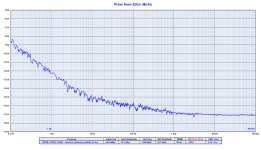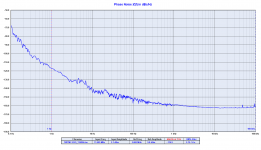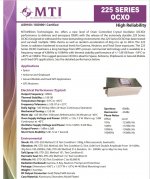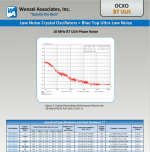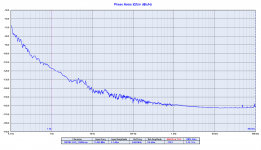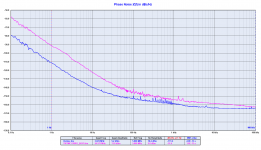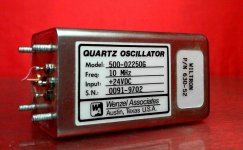What do you think of this clock unit?
-120bd at 1Hz for a 10mhz clock is extremely low, even lower than the 5mhz SC-cut clock.
MUTEC - Professional A/V and High-End Equipment - REF10 SE120
Actually the DRIXO at 5.6448 MHz has a little better phase noise: -123dBc against -120dBc at 1 Hz from the carrier and -155dBc against -148dBc at 10 Hz from the carrier.
And the EXO at 11.2896 MHz has almost similar phase noise performance (3dB worse): -117dBc against -120dBc at 1 Hz from the carrier and -145dBc against -148dBc at 10 Hz from the carrier.
At these levels of phase noise the crystal makes the difference, the 1/f3 noise is fully dominated by the random walk of the crystal due to the impurity of its surface.
It's would be curious to know what crystal they have used.
Usually higher overtone crystals perform better because they have higher ESR and so the loaded Q is maximized.
We will try soon a 5th overtone crystal at 11.2896 MHz in HC-47/U package.
The Q of this crystal is similar to the 3rd harmonic one (a little higher) but the ESR is double (around 200 ohm) so even the loaded Q will be higher.
Attachments
Last edited:
Just for comparison:
MTI-Milliren 225 OCXO 10MHz
10Hz -123dBc/Hz
100Hz -137dBc/Hz
1000Hz -139dBc/Hz
10000Hz -143dBc/Hz
Wenzel BT ULN 10 MHz
10Hz - 143dBc/Hz
100Hz -161dBc/Hz
1000Hz -173dBc/Hz
10000Hz -174dBc/Hz
TWTMC-EXO 11.2896 MHz
10Hz - 145dBc/Hz
100Hz -154dBc/Hz
1000Hz -159dBc/Hz
10000Hz -163dBc/Hz
It looks like the MTI 225 it's not "the best of the best" like someone claims.
Conversely it's "the worst of the compared oscillators".
But maybe I'm wrong, since I'm not measurements obsessed I'm not able to read the measured data.
MTI-Milliren 225 OCXO 10MHz
10Hz -123dBc/Hz
100Hz -137dBc/Hz
1000Hz -139dBc/Hz
10000Hz -143dBc/Hz
Wenzel BT ULN 10 MHz
10Hz - 143dBc/Hz
100Hz -161dBc/Hz
1000Hz -173dBc/Hz
10000Hz -174dBc/Hz
TWTMC-EXO 11.2896 MHz
10Hz - 145dBc/Hz
100Hz -154dBc/Hz
1000Hz -159dBc/Hz
10000Hz -163dBc/Hz
It looks like the MTI 225 it's not "the best of the best" like someone claims.
Conversely it's "the worst of the compared oscillators".
But maybe I'm wrong, since I'm not measurements obsessed I'm not able to read the measured data.
Attachments
Last edited:
J
It looks like the MTI 225 it's not "the best of the best" like someone claims.
It looks like somebody is unable to read what was posted. No one compared the MTI Millirad directly with a Wenzel. The MTI 225 was used as VCO in a fractional PLL, which is, ahem, quite a different story.
Secondly, any sane "measurement obsessed" engineer would not trust your measurements on the so-called TWTMC-EXO (nice, catchy name, makes it look more interesting, BTW), until independently verified. I know I don't, since your implementation looks like a toy compared to what is needed to come even close to that level of phase noise performance. A peek inside a Wenzel oscillator would be relevant, but I cannot hope you would do that and accept the reality.
Now, back to where you belong, my **** list.
Last edited:
While not a Wenzel (And I'm not going to open any of my 4 Wenzels) this is in a similar league: Inside the HP 10811 Dual Oven The HP 10811 is one of the go to standards and is well documented including its history and design.
I had occasion to ask the primary designer about changing the crystal for a different frequency. He recommended against it, Too many aspects to adjust and it would not go well, not to mention the special crystal package.
The TWTMC-EXO doesn't need to meet many of the specs required for one of the real high performance oscillators. Everything from environmental to drift rate really do not affect audio and would only be for bragging rights. And like the MUTEC an independent measurement would be good to validate the performance. Its still an exceptional result for some DIY'ers who started from nothing not long ago. Wenzel has been making SOTA oscillators for 40? years. Practice helps with all of the exotic stuff.
WRT the MTI- making a good tunable oscillator is another major challenge. Crystals do not pull very far and so you need to do some compromises to even get much tuning range.
I had occasion to ask the primary designer about changing the crystal for a different frequency. He recommended against it, Too many aspects to adjust and it would not go well, not to mention the special crystal package.
The TWTMC-EXO doesn't need to meet many of the specs required for one of the real high performance oscillators. Everything from environmental to drift rate really do not affect audio and would only be for bragging rights. And like the MUTEC an independent measurement would be good to validate the performance. Its still an exceptional result for some DIY'ers who started from nothing not long ago. Wenzel has been making SOTA oscillators for 40? years. Practice helps with all of the exotic stuff.
WRT the MTI- making a good tunable oscillator is another major challenge. Crystals do not pull very far and so you need to do some compromises to even get much tuning range.
we will remove the names on that list and you can try a 'blind test' to read which number is lowest, free of your own bias about what you think a low phase noise oscillator should 'look' like.
This level of performance is ridiculous for audio, enough said. One could do controlled listening until the cows come home and will never find a difference between clocks in this range of phase noise. But the Jiteratti team (@chris719) will always reject controlled listening tests by definition of their believes.
While not a Wenzel (And I'm not going to open any of my 4 Wenzels) this is in a similar league: Inside the HP 10811 Dual Oven The HP 10811 is one of the go to standards and is well documented including its history and design.
The 10811 is not in particular ultra low phase noise today, has <-120dBc @10Hz and <-90dBc @1Hz, but it was probably the best at the time it was designed.
A modern frac PLL, if correctly designed and the BW optimized has virtually no additive noise, the output performance is in principal defined by the VCO phase noise. Contrary to popular believe, a regular synchronous frequency divider has lots of additive noise... The secret of an ultra low noise frac PLL is to divide the VCO as deep as possible using an ultra low noise divider. I used the HMC988 https://www.analog.com/media/en/technical-documentation/data-sheets/hmc988.pdf to divide the 100MHz VCO and my (true, improvised implementation, without EMI protection, etc...) is still 20dB under a Wenzel but well over the MTI VCO phase noise.
It looks like someone does not know what is a Timepod (now Microsemi), he don't know how the cross correlation works and also he don't know what is a 3-cornered hat measurement which allow to measure a DUT better than the reference (that's the case of the DRIXO and the EXO since they measure better than the MTI 260 used as references).
It looks like he believe one can measure such level of phase noise with a spectrum analyzer, maybe with a poor time base.
Sometime the "measurement obsessed" engineer is a little confused.
Too much measurements wear down the neurons.
Sometimes it would be better to measure less and listen more to music.
It's relaxing and helps neurons get back to doing their job.
It looks like he believe one can measure such level of phase noise with a spectrum analyzer, maybe with a poor time base.
Sometime the "measurement obsessed" engineer is a little confused.
Too much measurements wear down the neurons.
Sometimes it would be better to measure less and listen more to music.
It's relaxing and helps neurons get back to doing their job.
It looks like he believe one can measure such level of phase noise with a spectrum analyzer, maybe with a poor time base.
It looks like he is using an 89410a
But his post was quite full of blissful ignorance, otherwise he would have recognized the multiple design features which characterize the works of B. G, which You have duly recognized in your introduction to the project.
Not talking about the report screen of a Timepod/Microsemi 3120a, which he is claiming a bogus instrument, etc etc.. Long list
It looks like he is using an 89410a
But his post was quite full of blissful ignorance, otherwise he would have recognized the multiple design features which characterize the works of B. G, which You have duly recognized in your introduction to the project.
Not talking about the report screen of a Timepod/Microsemi 3120a, which he is claiming a bogus instrument, etc etc.. Long list
There are very smart RF engineers like John Miles, Bruce Griffiths, Arthur Everard, Richard K. Karlquist, Enrico Rubiola, Pat Di Giacomo (R.I.P.) and so on.
Then there are the self-proclaimed ones (who, however, did not understand how to measure phase noise).
No comment.
P.S.
I have a comment: it's sad.
Not talking about the report screen of a Timepod/Microsemi 3120a, which he is claiming a bogus instrument, etc etc..
The instrument is not bogus. Until independently proven, his user is. But of course, asking an independent lab to evaluate the results is out of discussion, everything has to be based on trust only.
And of course some are blissfully ignorant. This is what your targeted customers needs to hear from the Jiteratti team, to keep up the sales.
Gerhard,
nothing count, you need an Audio Precision tool to measure the phase noise, like the one used by the Lord of the Blue Screen.
Just was I expected,
in the end, after someone has wrote one nonsense after another, he must resort the insults to save the face.
And it's very trange that the minions haven't arrived yet.
I'm really worried about.
nothing count, you need an Audio Precision tool to measure the phase noise, like the one used by the Lord of the Blue Screen.
Just was I expected,
in the end, after someone has wrote one nonsense after another, he must resort the insults to save the face.
And it's very trange that the minions haven't arrived yet.
I'm really worried about.
Last edited:
until independently verified. I know I don't, since your implementation looks like a toy compared to what is needed to come even close to that level of phase noise performance. A peek inside a Wenzel oscillator would be relevant, but I cannot hope you would do that and accept the reality.
I won't cut open the Wenzel in my SR620 time interval counter, but I
can offer a peek inside a Morion MV89A if you want. But most of it is
the double oven, which is of less interest here.
Or a FEI 405 unit that I could open without grinding or soldering.
OK, not to the crystals. I still need it.
It has awful far-out output spectrum, but the carrier goes deep into
ADEV E-13 land at seconds to minutes (Low freq).
Listened to it with great interest at a Toronto audio show.What do you think of this clock unit?
-120bd at 1Hz for a 10mhz clock is extremely low, even lower than the 5mhz SC-cut clock.
MUTEC - Professional A/V and High-End Equipment - REF10 SE120
I enjoy Pass Labs stuff so always check out Toronto Home of Audiophile. I enjoyed the Triton One speakers they were using. Seemed very organic for a hotel room with amazing bass. Their source was using the MUTEC master clock. I recognized the sound of a low phase noise clock immediately. The owner agreed to pull the master clock out and play with the Lumin streamer straight to Pass electronics. Still great, but a different league. Very similar to what we all report with Andre's Well Tempered MC.
A toy, just a toy compared to what is needed to bla bla bla ....
a toy with the same phase noise of the best oscillators on the market.
And I would remark "phase noise", otherwise someone get confused with the Allan Deviation.
Not bad for a couple of stupid audio hobbyists.
Although the most merit is of Bruce Griffiths and Jeremy Everard (the starting point of our DRIXO and EXO oscillators).
a toy with the same phase noise of the best oscillators on the market.
And I would remark "phase noise", otherwise someone get confused with the Allan Deviation.
Not bad for a couple of stupid audio hobbyists.
Although the most merit is of Bruce Griffiths and Jeremy Everard (the starting point of our DRIXO and EXO oscillators).
I won't cut open the Wenzel in my SR620 time interval counter, but I
can offer a peek inside a Morion MV89A if you want. But most of it is
the double oven, which is of less interest here.
Or a FEI 405 unit that I could open without grinding or soldering.
OK, not to the crystals. I still need it.
It has awful far-out output spectrum, but the carrier goes deep into
ADEV E-13 land at seconds to minutes (Low freq).
I have myself a 10MHz spare Wenzel 500-02250G for my Anritsu/Wiltron 6769A 40GHz digital synthesizer and also not willing to crack it open. A power monster, takes about 20W from 24V after warming up, but the stability and phase noise are beyond anything that I have measured with my own hands (under -155dBc @10Hz and slightly under -120dBc @1Hz). It is used as a reference in the synthesizer 500MHz PLL reference loop (pic is from the Internet).
And you guys can invoke concepts like "regenerative divider" that you have no clue about, to impress your potential customers, as much as you want: it is a fact that any common frequency divider introduces much more additive phase noise than they avoid by dividing the source. Asking Larry Page would immediately reveal the phase noise introduced by the simplest flip-flop. This is the core stupidity in claiming an ultra low phase noise clock makes any difference for audio applications: you pass the ultra low phase noise through a bunch of internal logic and clock distribution inside the DAC chip which adds phase noise way over the original. I would suggest looking at my instrumentation DAC, reaching -112dB SINAD with an "ordinary" clock like the Si570. Yes, I know, we don't know how to measure what our ears are telling us, so we should dump all the instrumentation, except those serving our marketing message, like a misused Timepod.
You guys, if you dare, send your best oscillator to Gerhard (not to me, since I am your arch enemy); he's the guy I would trust with such measurements, and your product will get the rubber stamp of a recognized professional. He's very close to you in Germany, it won't cost you almost anything, but just in case, send me the postal invoice and I am willing to cover it.
Attachments
Last edited:
- Status
- Not open for further replies.
- Home
- Source & Line
- Digital Line Level
- The Well Tempered Master Clock - Building a low phase noise/jitter crystal oscillator
